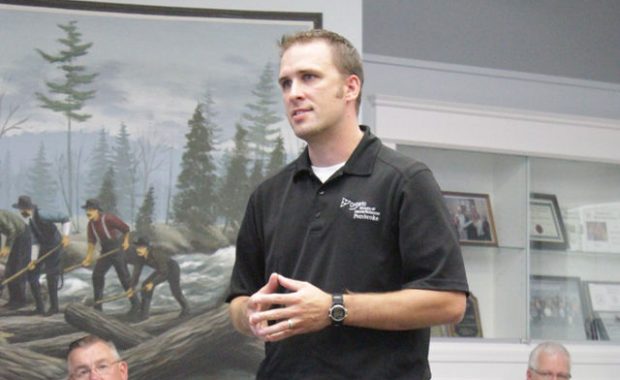KILLALOE – In an effort to bump up the number of lake trout in Round Lake, the Ministry of Natural Resources will be stocking the species over the next few years.
Darwin Rosien is a senior fish and wildlife technical specialist at the MNR Pembroke District office. He attended the July 17 Killaloe-Hagarty-Richards council meeting to discuss the initiative with municipal leaders.
Last year, a total of 17,000 lake trout eggs were collected from Round Lake and shipped to the North Hastings Community Fish Hatchery in Bancroft. It is a new, private, state of the art hatchery that utilizes a re-circulating system that helps better control the water temperature.
Rosien said the system allows for lake trout to grow in a short amount of time. In fact, he said that in provincial hatcheries, it takes around 22 months for lake trout to grow 22 grams. The hatchery in Bancroft will produce 40-gram fish in 12 months.
“For our purposes, that is fantastic,” he said. “We have tried a number of things and we are at the conclusion…that we want to try to rehabilitate the stock.”
Stocking will happen for at least three years. The MNR is granting $15,000 for the project, which is $5,000 per year. It will cost $1 to rear each fish at the private hatchery.
“My intended goal is to restore a sufficient number of lake trout to enable a self-sustaining population,” Rosien explained. “They can reproduce on their own; they are doing that right now. Just for some reason, I think there is an imbalance in predator-prey relationship.”
Out of the 250,000 lakes in Ontario, only 2,200 can support lake trout. While many of them are in Algonquin Park, 24 of those lakes are within the Pembroke MNR district.
The populations in Ontario represent 20-25 per cent of the global population of the species.
“We are pretty privileged here in Ontario to have the lake trout that we have,” he said. “Even though we have 250,000 lakes in the province, lake trout lakes are very rare.”
Extensive studying has been done on the fish population in Round Lake. In 2007, samples were sent out to geneticists. The samples were compared to hatchery strains and other known varieties. Rosien said the DNA results indicate that lake trout in Round Lake are genetically unique.
“Even though there was fish stocking in Round Lake in the past, those genes – they didn’t seem to mix with the natural strains in Round Lake at all. They are very unique; they are not like any other hatchery strains or wild strains out there. They are very dissimilar,” Rosien explained.
Around 10,000 years ago, during the last glacial thaw, the fish were left isolated in the lake. This means that the lake trout in Round Lake have a unique set of traits and characteristics that enable them to best survive in that environment compared to another strain of fish.
“As MNR, we have a huge responsibility in managing that resource,” Rosien explained. “Both in terms of not only managing the species, but also individual populations and preserving those genetics. Once they are gone, they are gone.”
The MNR performs two different kinds of stocking – Put, Grow and Take (PGT) or rehabilitative. PGT occurs to lakes that do not have genetically unique fish. Rehabilitative involves collecting eggs from the native species and rearing them in a hatchery, which are later released back into the lake.
“Ideally, we would like to take those eggs and put them in a provincial hatchery but we can’t do that because it is disease-controlled,” he said. “There are very stringent disease control requirements that require several generations of fish being killed and tested in order to get into a provincial hatchery. We don’t want to do that with Round Lake because that would be counter-productive.”
Rosien said it would require killing 50 fish a year for several years. Today, he estimates there are 600-1,000 adult fish in the lake today.
“We don’t want to do anything that would hurt that population further,” he said. “We want to maintain that breeding stock that is there right now.”
The easiest and most cost-effective solution, Rosien said, is to rear the fish in a private hatchery, where there are no disease regulations.
Story continues in the July 25 issue of The Valley Gazette.
